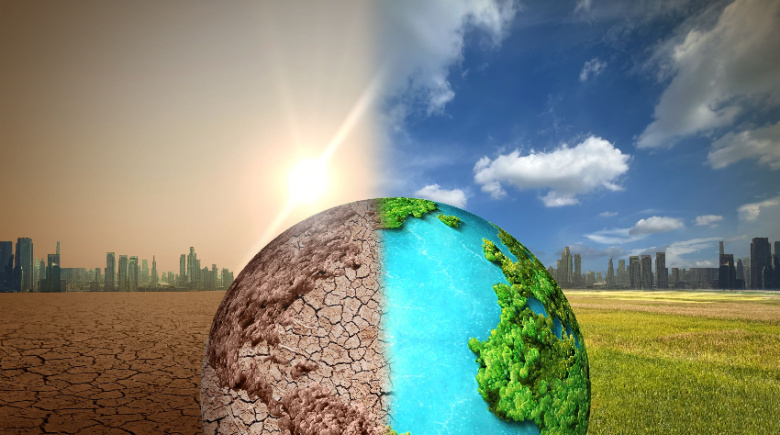The Earth is facing numerous urgent environmental issues that require immediate attention. The stark reality is that many of these issues are disasters caused by climate-induced events. These are the most dire issues that people worldwide are facing in 2025.
Acidification of Oceans
At least 30 percent of the carbon dioxide that’s released into Earth’s atmosphere goes into the ocean. Changes in ocean acidity can be devastating to marine habitats, ocean ecosystems, food sources, and the quality of marine habitats. Some marine species, like oysters, could begin to dissolve when pH levels get too low.
Air Pollution
According to World Health Organization statistics, between 4.2 and 7 million people die each year from air pollution. Nine out of every ten people breathe air that contains high levels of pollutants. Most air pollution comes from vehicles and industrial pollution. Strengthening dust storms also contribute to this serious problem.
Agriculture
At least 30 percent of all greenhouse gas emissions caused by humans come from fishing and livestock. Greenhouse gases like nitrous oxide in fertilizers are used in growing crops. Cattle ranching encompasses 60 percent of the world’s agriculture and uses massive amounts of water and land. The carbon footprint could be reduced by using more sustainable methods of farming and consuming plant-based diets.
Deforestation
One of the most startling statistics is that within a century, our planet’s forests could be gone if deforestation isn’t stopped. Each hour, a forest the size of 300 football fields is cut down. By 2030, the planet may only have 10 percent of its forests left. The countries contributing the most to deforestation are Brazil, Indonesia, and the Democratic Republic of the Congo. The Amazon is the largest rainforest in the world and the habitat to three million species of animals and plants.
Dependence on Fossil Fuels
Some economists have theorized that the primary cause of our climate crisis is due to the failure of multiple markets. For several decades, experts on economics and the environment have urged lawmakers to increase the prices on industry activities that increase greenhouse gases. Carbon taxes would encourage industries to adopt new policies to lower the amount of greenhouse gas emissions. In 27 countries, a national carbon tax has been implemented, but it’s not sufficient. Higher taxes on the electricity industry have been put in place, and a similar tax has been suggested for the coal industry.
Loss of Biodiversity
Population growth, urbanization, worldwide trade, and consumption by humans in the past 50 years mean more resources are being used than can be replenished easily. World Wildlife Fund statistics indicate that populations of amphibians, birds, fish, mammals, and reptiles have declined at a devastating average of 68 percent between 1970 and 2016. The illegal wildlife trade and the conversion of wildlife habitats for agriculture are the primary causes.
Earth is on the brink of the sixth mass extinction of animal species. More than 500 land animal species are expected to become extinct within the next 20 years. The sad statistic is that scientists are stating that if it weren’t for humans destroying nature’s habitats, the extinction would have taken thousands of years.
Mining Cobalt
Cobalt is a component used to manufacture batteries for electric-powered vehicles. Cobalt mining has serious social and environmental issues. The largest supplier of cobalt worldwide is the Democratic Republic of the Congo, contributing to one-fifth of the world’s production. The DRC produces cobalt and copper, but also has large amounts of uranium, with high levels of radioactivity in some areas. Industrial and mineral mining is causing pollution that gets into streams and rivers. Pulverized rock dust is causing people in local communities to develop breathing problems.
Overfished Waters
People are consuming more food, and there are four times more people on Earth as there were in the 1960s. At least 30 percent of the waters fished by commercial fishermen are now overfished. What this means is that the stock of fish is being depleted faster than it can be replaced. Other problems with overfishing are littering the oceans, loss of biodiversity, and increased algae in the water.
Plastic Pollution
In 2015, 419 million tons of plastic were produced, adding to increased land and water pollution. Animals and wildlife habitats are harmed each year by the 14 million tons of plastic in the ocean. Plastic is one of the worst causes of environmental damage since it takes 400 years to totally decompose. The UN is working on an international treaty to curb pollution. The delegation hasn’t reached a conclusuon yet.
Rising Sea Levels and Melting Ice Caps
The devastating climate crisis is warming the Arctic faster than any place on Earth. Due to rising temperatures, sea levels are rising faster now than what occurred for most of the 20th century. The melting of the Greenland Ice Sheet poses most of the risk since ice melting on land is causing sea levels to rise. At least 60 billion tons of ice were lost from the Greenland Ice Sheet in 2020. The Emperor Penguins in Antarctica are facing extinction by 2100 if climate change isn’t controlled.
Textile Industry Waste
The fashion industry is responsible for ten percent of carbon emissions globally. The industry produces more gas emissions than the shipping and aviation industries combined. and produces 20 percent of all wastewater globally. Around 93 billion cubic meters of water are wasted from textile dyeing.
Water and Food Insecurity
At least one-third of the food intended for human consumption, or more than one billion tons, is wasted each year. The loss and waste of this food contribute to one-quarter of the greenhouse gases that are emitted annually. The food that’s wasted or lost could feed three billion people. If food waste were a country, it would be the third for greenhouse gas emissions. The United States ranks highest, with China in second place. The two primary reasons for water and food insecurity are farming practices that aren’t sustainable and rising global temperatures. Only three percent of Earth’s water supply is fresh water. More than one billion people don’t have access to fresh water.
The Earth is facing numerous urgent environmental issues that require immediate attention. The stark reality is that many of these issues are disasters caused by climate-induced events. These are the most dire issues that people worldwide are facing in 2025.
Acidification of Oceans
At least 30 percent of the carbon dioxide that’s released into Earth’s atmosphere goes into the ocean. Changes in ocean acidity can be devastating to marine habitats, ocean ecosystems, food sources, and the quality of marine habitats. Some marine species, like oysters, could begin to dissolve when pH levels get too low.
Air Pollution
According to World Health Organization statistics, between 4.2 and 7 million people die each year from air pollution. Nine out of every ten people breathe air that contains high levels of pollutants. Most air pollution comes from vehicles and industrial pollution. Strengthening dust storms also contribute to this serious problem.
Agriculture
At least 30 percent of all greenhouse gas emissions caused by humans come from fishing and livestock. Greenhouse gases like nitrous oxide in fertilizers are used in growing crops. Cattle ranching encompasses 60 percent of the world’s agriculture and uses massive amounts of water and land. The carbon footprint could be reduced by using more sustainable methods of farming and consuming plant-based diets.
Deforestation
One of the most startling statistics is that within a century, our planet’s forests could be gone if deforestation isn’t stopped. Each hour, a forest the size of 300 football fields is cut down. By 2030, the planet may only have 10 percent of its forests left. The countries contributing the most to deforestation are Brazil, Indonesia, and the Democratic Republic of the Congo. The Amazon is the largest rainforest in the world and the habitat to three million species of animals and plants.
Dependence on Fossil Fuels
Some economists have theorized that the primary cause of our climate crisis is due to the failure of multiple markets. For several decades, experts on economics and the environment have urged lawmakers to increase the prices on industry activities that increase greenhouse gases. Carbon taxes would encourage industries to adopt new policies to lower the amount of greenhouse gas emissions. In 27 countries, a national carbon tax has been implemented, but it’s not sufficient. Higher taxes on the electricity industry have been put in place, and a similar tax has been suggested for the coal industry.
Loss of Biodiversity
Population growth, urbanization, worldwide trade, and consumption by humans in the past 50 years mean more resources are being used than can be replenished easily. World Wildlife Fund statistics indicate that populations of amphibians, birds, fish, mammals, and reptiles have declined at a devastating average of 68 percent between 1970 and 2016. The illegal wildlife trade and the conversion of wildlife habitats for agriculture are the primary causes.
Earth is on the brink of the sixth mass extinction of animal species. More than 500 land animal species are expected to become extinct within the next 20 years. The sad statistic is that scientists are stating that if it weren’t for humans destroying nature’s habitats, the extinction would have taken thousands of years.
Mining Cobalt
Cobalt is a component used to manufacture batteries for electric-powered vehicles. Cobalt mining has serious social and environmental issues. The largest supplier of cobalt worldwide is the Democratic Republic of the Congo, contributing to one-fifth of the world’s production. The DRC produces cobalt and copper, but also has large amounts of uranium, with high levels of radioactivity in some areas. Industrial and mineral mining is causing pollution that gets into streams and rivers. Pulverized rock dust is causing people in local communities to develop breathing problems.
Overfished Waters
People are consuming more food, and there are four times more people on Earth as there were in the 1960s. At least 30 percent of the waters fished by commercial fishermen are now overfished. What this means is that the stock of fish is being depleted faster than it can be replaced. Other problems with overfishing are littering the oceans, loss of biodiversity, and increased algae in the water.
Plastic Pollution
In 2015, 419 million tons of plastic were produced, adding to increased land and water pollution. Animals and wildlife habitats are harmed each year by the 14 million tons of plastic in the ocean. Plastic is one of the worst causes of environmental damage since it takes 400 years to totally decompose. The UN is working on an international treaty to curb pollution. The delegation hasn’t reached a conclusuon yet.
Rising Sea Levels and Melting Ice Caps
The devastating climate crisis is warming the Arctic faster than any place on Earth. Due to rising temperatures, sea levels are rising faster now than what occurred for most of the 20th century. The melting of the Greenland Ice Sheet poses most of the risk since ice melting on land is causing sea levels to rise. At least 60 billion tons of ice were lost from the Greenland Ice Sheet in 2020. The Emperor Penguins in Antarctica are facing extinction by 2100 if climate change isn’t controlled.
Textile Industry Waste
The fashion industry is responsible for ten percent of carbon emissions globally. The industry produces more gas emissions than the shipping and aviation industries combined. and produces 20 percent of all wastewater globally. Around 93 billion cubic meters of water are wasted from textile dyeing.
Water and Food Insecurity
At least one-third of the food intended for human consumption, or more than one billion tons, is wasted each year. The loss and waste of this food contribute to one-quarter of the greenhouse gases that are emitted annually. The food that’s wasted or lost could feed three billion people. If food waste were a country, it would be the third for greenhouse gas emissions. The United States ranks highest, with China in second place. The two primary reasons for water and food insecurity are farming practices that aren’t sustainable and rising global temperatures. Only three percent of Earth’s water supply is fresh water. More than one billion people don’t have access to fresh water.



